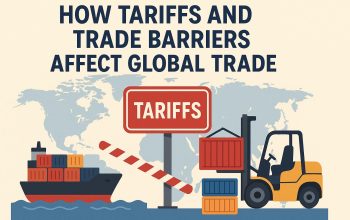Understanding Aggregate Demand
In the realm of macroeconomics, aggregate demand (AD) is a fundamental concept that encompasses the total quantity of goods and services demanded across all economic levels at a particular price level and within a specific time frame. This concept is vital for analyzing overall economic activity and plays a crucial role in guiding various policy decisions. Aggregate demand reflects the relationship between the overall price level and the total demand for an economy’s output, helping economists and policymakers understand consumer behavior, investment trends, and government spending.
Components of Aggregate Demand
The aggregate demand within an economy can be quantitatively expressed using the formula AD = C + I + G + (X – M), where each symbol represents a distinct component. These components collectively illustrate the different facets of demand:
C stands for consumption expenditure. This includes all private expenditures by households on a vast array of goods and services, ranging from everyday necessities like food and clothing to durable goods such as vehicles and electronics. Consumption expenditure is often regarded as the most significant component of aggregate demand, as household spending reflects consumer confidence and economic well-being.
I denotes investment expenditure. This element captures business investments in capital goods, including machinery, equipment, and development projects like residential construction. Investment expenditure is critical for economic growth, as it indicates how businesses are investing in their productive capacity and future output. This component can fluctuate significantly based on business confidence and economic expectations.
G signifies government spending on goods and services that are consumed by the public. It excludes transfer payments such as pensions and unemployment benefits, focusing instead on infrastructure projects, public sector salaries, and defense spending. Government spending directly influences aggregate demand, with expansionary fiscal policies increasing demand through higher expenditures.
(X – M) represents net exports, where X is the value of exports, and M denotes imports. Net exports capture the demand for a nation’s goods and services from foreign markets versus domestic demand for foreign goods and services. A positive net export position means that exports exceed imports, contributing positively to aggregate demand.
Factors Influencing Aggregate Demand
The total aggregate demand in an economy can shift due to several influential factors, which have significant implications for economic performance and stability:
Changes in consumer confidence: Consumer sentiment plays a pivotal role in shaping aggregate demand. When consumers have an optimistic outlook towards the future, they are more likely to engage in increased spending, thereby boosting aggregate demand. Conversely, pessimism or uncertainty can result in decreased consumption, reducing demand levels.
Monetary policy: Central banks use monetary policy to influence aggregate demand through control of interest rates and credit availability. Lower interest rates reduce the cost of borrowing, encouraging consumer spending and business investment. Conversely, higher rates discourage borrowing and can dampen aggregate demand.
Fiscal policy: Government decisions on taxation and public expenditure have direct effects on aggregate demand. For instance, tax cuts increase disposable income, fostering higher consumption, while increased government spending can directly elevate demand.
Exchange rates: The value of a nation’s currency relative to others impacts net exports. A depreciation of the currency makes domestic goods cheaper for foreign buyers, potentially increasing exports and aggregate demand. Conversely, currency appreciation can reduce demand by making exports more expensive.
Understanding Aggregate Supply
Aggregate supply (AS) depicts the total output that producers in an economy are willing and capable of supplying at a given overall price level during a specific period. Similar to aggregate demand, it holds significant importance in assessing economic performance, stability, and potential output constraints.
Short-Run vs. Long-Run Aggregate Supply
The concept of aggregate supply can be distinguished into short-run and long-run perspectives, each with unique characteristics:
Short-Run Aggregate Supply (SRAS): In the short run, certain input prices, such as wages and raw material costs, remain sticky, not adjusting immediately to changes in price levels. This stickiness results in an upward-sloping SRAS curve, indicating that producers are willing to increase output in response to higher prices, albeit temporarily.
Long-Run Aggregate Supply (LRAS): Over the long term, input prices and wages adjust fully to changes in the general economic environment. Consequently, the LRAS curve becomes vertical, reflecting an economy’s maximum sustainable output level, unaffected by fluctuations in the price level. This output level is determined by resources, technology, and institutional factors.
Factors Affecting Aggregate Supply
Various elements can lead to shifts in the SRAS or LRAS curves, affecting overall aggregate supply and economic equilibrium:
Changes in input prices: Variations in the prices of inputs, such as oil or labor, directly impact production costs and profitability. An increase in production costs can reduce aggregate supply by squeezing profit margins, while declining input prices can enhance supply.
Technological advancements: Technological improvements that enhance efficiency and productivity can significantly boost aggregate supply. These advancements allow producers to achieve higher output levels with the same amount of resources, shifting supply curves outward.
Labor market dynamics: Factors such as wage trends, labor supply changes, and productivity gains influence aggregate supply. Increases in labor productivity empower firms to produce more output, while labor shortages may constrain supply.
Government regulations: Policies that affect production, such as environmental regulations or taxes on businesses, can alter aggregate supply. While some regulations might enhance production quality or sustainability, others may increase production costs, influencing supply curve shifts.
Interaction Between Aggregate Demand and Aggregate Supply
The interaction between aggregate demand and aggregate supply determines the overall level of economic activity, influencing output and price levels within the economy. An equilibrium occurs when aggregate demand intersects aggregate supply, signifying a state of economic balance. However, various shifts in either curve can lead to fluctuations, producing periods of economic growth or contraction. Understanding these dynamics enables economists and policymakers to implement measures that stabilize the economy, mitigate adverse effects of fluctuations, and promote sustainable growth.
This article was last updated on: June 2, 2025




